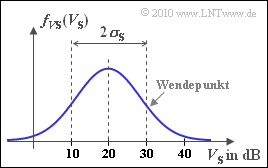Difference between revisions of "Aufgaben:Exercise 1.2: Lognormal Channel Model"
| Line 25: | Line 25: | ||
Notes:'' | Notes:'' | ||
| − | * | + | * This task belongs to the chapter [[Mobile_Kommunikation/Distanzabh%C3%A4ngige_D%C3%A4mpfung_und_Abschattung|Distanzabhängige Dämpfung und Abschattung]]. |
* You can use the following (rough) approximations for the complementary Gaussian error integral: | * You can use the following (rough) approximations for the complementary Gaussian error integral: | ||
| − | $${\rm Q}(1) \approx 0.16\hspace{0.05cm},\hspace{0.2cm} {\rm Q}(2) \approx 0.02\hspace{0.05cm},\hspace{0.2cm} | + | :$${\rm Q}(1) \approx 0.16\hspace{0.05cm},\hspace{0.2cm} {\rm Q}(2) \approx 0.02\hspace{0.05cm},\hspace{0.2cm} |
| − | {\rm Q}(3) \approx 10^{-3}\hspace{0.05cm}.$ | + | {\rm Q}(3) \approx 10^{-3}\hspace{0.05cm}.$$ |
| − | * Or use the interaction module provided by $\rm | + | * Or use the interaction module provided by $\rm LNTwww$ [[Applets:Komplementäre_Gaußsche_Fehlerfunktionen_(neues_Applet)|Komplementäre Gaußsche Fehlerfunktionen]]. |
| − | ===Questionnaire== | + | ===Questionnaire=== |
<quiz display=simple> | <quiz display=simple> | ||
| Line 42: | Line 42: | ||
- No. | - No. | ||
| − | The | + | {The parameters of the lognormal distribution are $m_{\rm S} = 20 \, \rm dB$ and $\sigma_{\rm S} = 0 \, \rm dB$. What percentage of the time does the system work? |
|type="{}"} | |type="{}"} | ||
${\rm Pr(System \ works)} \ = \ $ { 100 3% } $\ \%$ | ${\rm Pr(System \ works)} \ = \ $ { 100 3% } $\ \%$ | ||
| Line 50: | Line 50: | ||
${\rm Pr(System \ works)}\ = \ $ { 98 3% } $\ \%$ | ${\rm Pr(System \ works)}\ = \ $ { 98 3% } $\ \%$ | ||
| − | {How big can $V_0$ be | + | {How big can $V_0$ be at most, so that the reliability of $99.9\%$ is reached? |
|type="{}"} | |type="{}"} | ||
$V_0 \ = \ $ { 70 3% } $\ \ \rm dB$ | $V_0 \ = \ $ { 70 3% } $\ \ \rm dB$ | ||
| − | </quiz | + | </quiz> |
| − | === | + | ===Sample solution=== |
| − | {{ML | + | {{ML-Kopf}} |
| − | '''(1)''' | + | '''(1)''' The correct answer is <u>YES</u>: |
*From the $\rm dB$–value $V_0 = 80 \ \rm dB$ follows the absolute (linear) value $K_0 = 10^8$. Thus the received power is | *From the $\rm dB$–value $V_0 = 80 \ \rm dB$ follows the absolute (linear) value $K_0 = 10^8$. Thus the received power is | ||
$$P_{\rm E} = P_{\rm S}/K_0 = 10 \ {\rm W}/10^8 = 100 \ {\rm nW} > 10 \ \ \rm pW.$$ | $$P_{\rm E} = P_{\rm S}/K_0 = 10 \ {\rm W}/10^8 = 100 \ {\rm nW} > 10 \ \ \rm pW.$$ | ||
Revision as of 16:05, 25 March 2020
We consider a mobile radio cell in an urban area and a vehicle that is approximately at a fixed distance $d_0$ from the base station. For example, it moves on an arc around the base station.
Thus the total path loss can be described by the following equation: $$V_{\rm P} = V_{\rm 0} + V_{\rm S} \hspace{0.05cm}.$$
- $V_0$ takes into account the distance-dependent path loss which is assumed to be constant: $V_0 = 80 \ \rm dB$ .
- The loss $V_{\rm S}$ is due to shadowing caused by the lognormal–distribution with the probability density function (PDF)
- $$f_{V{\rm S}}(V_{\rm S}) = \frac {1}{ \sqrt{2 \pi }\cdot \sigma_{\rm S}} \cdot {\rm exp } \left [ - \frac{ (V_{\rm S}- m_{\rm S})^2}{2 \cdot \sigma_{\rm S}^2} \right ] \hspace{0.05cm}$$
- see diagram. The following numerical values apply:
$$m_{\rm S} = 20\,\,{\rm dB}\hspace{0.05cm},\hspace{0.2cm} \sigma_{\rm S} = 10\,\,{\rm dB}\hspace{0.15cm}{\rm or }\hspace{0.15cm}\sigma_{\rm S} = 0\,\,{\rm dB}\hspace{0.15cm}{\rm (subtask\hspace{0.15cm} 2)}\hspace{0.05cm}.$$
Also make the following simple assumptions:
- The transmit power is $P_{\rm S} = 10 \ \rm W$ (or $40 \ \rm dBm$).
- The receive power should be at least $P_{\rm E} = 10 \ \rm pW$ (or $–80 \ \rm dBm$)
Notes:
- This task belongs to the chapter Distanzabhängige Dämpfung und Abschattung.
- You can use the following (rough) approximations for the complementary Gaussian error integral:
- $${\rm Q}(1) \approx 0.16\hspace{0.05cm},\hspace{0.2cm} {\rm Q}(2) \approx 0.02\hspace{0.05cm},\hspace{0.2cm} {\rm Q}(3) \approx 10^{-3}\hspace{0.05cm}.$$
- Or use the interaction module provided by $\rm LNTwww$ Komplementäre Gaußsche Fehlerfunktionen.
Questionnaire
Sample solution
- From the $\rm dB$–value $V_0 = 80 \ \rm dB$ follows the absolute (linear) value $K_0 = 10^8$. Thus the received power is
$$P_{\rm E} = P_{\rm S}/K_0 = 10 \ {\rm W}/10^8 = 100 \ {\rm nW} > 10 \ \ \rm pW.$$
- You can also solve this problem directly with the logarithmic quantities:
$10 \cdot {\rm lg}\hspace{0.15cm} \frac{P_{\rm E}}}{1\,\,{\rm mW}} = 10 \cdot {\rm lg}\hspace{0.15cm} \frac{P_{\rm S}}{1\,\,{\rm mW}} - V_0 = 40\,{\rm dBm} -80\,\,{\rm dB} = -40\,\,{\rm dBm} \hspace{0.05cm}.'"`UNIQ-MathJax19-QINU`"'{\rm Pr}({\rm "System\hspace{0.15cm} does not work\hspace{0.15cm}"})= {\rm Q}\left ( \frac{20\,\,{\rm dB}}}{\sigma_{\rm S} = 10\,{\rm dB}\right ) = {\rm Q}(2) \approx 0.02\hspace{0.3cm} \Rightarrow \hspace{0.3cm}{\rm Pr}({\rm "System\hspace{0.15cm} works"})= 1- 0.02 \hspace{0.15cm} \underline{\approx 98\,\%}\hspace{0.05cm}.'"`UNIQ-MathJax20-QINU`"'{\rm Pr}({\rm "System\hspace{0.15cm}funktioniert\hspace{0.15cm}nicht"})= {\rm Q}\left ( \frac{120-70-20}{10}\right ) = {\rm Q}(3) \approx 0.001 \hspace{0.05cm}.'"`UNIQ-MathJax21-QINU`"'{\rm Pr}({\rm "System\hspace{0.15cm} does not work\hspace{0.15cm}"})= {\rm Q}\left ( \frac{120-70-20}{10}\right ) = {\rm Q}(3) \approx 0.001 \hspace{0.05cm}.$$
